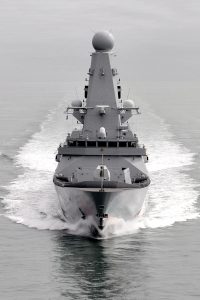Enhancing maritime electronic warfare capability
Author: Andy Haslam, Director of Business Development, PPM Systems
Electronic Warfare (EW) systems typically deliver capability through two approaches: Passive or Active. The passive approach is where the system is receive only, so signals are received and analysed to provide useful intelligence, whereas the active approach also includes the transmission of specific signals that are often aimed at jamming, spoofing, disrupting, denying, defeating or stimulating an effect from otherwise passive sensors.
 The Challenges of a Coaxial Based Maritime EW System
The Challenges of a Coaxial Based Maritime EW System
A Maritime EW system will typically consist of one or more antennas linked to one of more signal generators and or receivers. This enables RF Signals of Interest (SoI) to be captured and analysed for Signals Intelligence (SIGINT); or RF signals to generated and transmitted to disrupt, deny, or defeat threats. The connectivity between antennas and either signal generators or receivers is typically via coaxial cabling, which has a number of challenges as follows:
Reduced Engagement Range for Electronic Attack (EA) Effects
Coaxial data distribution systems typically use power amplification that is co-located with, or a part of, the signal generation equipment that generates the effect. This equipment is typically deep inside the platform, which leads to reduced RF transmit power at the antenna through the coaxial cable losses, which in turn reduces the engagement range for the EA effect.
Sub-Optimal Antenna Placement
Antenna placement relative to targets and other RF emitters on the platform is key in delivering an effective capability. Given a typical EW system uses coaxial cabling, the antennas have to be close enough to the signal receivers / generators (that are typically buried deep in the ship) to ensure that even high power signals are not attenuated to the point of being undetectable at the signal receivers, or have little to no transmit power for engaging a target. The constraint typically leads to antennas being located in a sub-optimal positions e.g., located near to an RF emitter that interferes with received signals.
Reduced Detection Range for Electronic Surveillance (ES)
Coaxial cabling attenuates the received signals with an increase magnitude of attenuation as the frequency and or cable length increases. As the signal receiver equipment is typically deep inside the platform, lower strength signals received at the antenna will drop into the noise floor by the time they reach the signal receiver, reducing the detection range for an ES capability.
Fixed Point-To-Point (P2P) Network Topologies
Given a typical EW system uses coaxial cabling in a fixed point-to-point network topology, this often links specific antennas in sub-optimal positions to wideband signal generators / receivers with reduced scope. The often very capable and wideband signal generators / receivers are typically linked to a banded antenna, effectively limiting the scope of the signal generator / receiver to that of the antenna.
Benefits of an RFoF Based EW System
Defence’s operating environment is constantly evolving, with frequencies of interest rising, and the additional response and engagement time afforded by improved detection and engagement range becoming more important – the use of an effective signal distribution solution such as RFoF will be crucial in maintaining a tactical edge; benefits include:
Lossless Single Mode Fibre Optic Cabling
Losing only 0.02 dB over 10 m compared to a loss of 3.6 dB over 10 m for coaxial (LMR-400-DB coaxial cable at 6 GHz and fibre optic at 1550 nm), an RFoF distribution solution will provide a step change in EW capability, as well as supporting the coexistence of both analogue and digital RF formats to maintain future flexibility. The lossless nature of an RFoF distribution solution manifests as a 5x increase in detection range (compared to a 10 m coaxial based antenna at 18 GHz), and a 7x increase in engagement range (compared to a 4 m coaxial based antenna at 6 GHz with equivalent amplification).
Antenna Suite Optimisation
The lossless nature of the fibre optic cabling removes any constraint on distance between antenna and signal generator / receiver. This enables the antenna position to be optimised to: Reduce interference from other platform RF emitters, and / or to improve field of ‘view’ for unimpaired receiving / transmitting of RF signals.
Optical Distribution (Hub / Star Network Topology)
An RFoF based solution enables a hub / star network topology, where any antenna and signal generator / receiver link can be mapped, and the signal routed. This enables the EW system to dynamically optimise to the operational threat and theatre almost instantly (in less than a second). This dynamic routing, or any-to-any mapping, removes the previous scope limitations and unlocks the full capability of the typically wideband signal generators / receivers in the EW system.

5X INCREASE IN DETECTION RANGE
Compared to a 4 m coaxial based antenna at 6 GHz with equivalent amplification.
7X INCREASE IN ENGAGEMENT RANGE
Compared to a 4 m coaxial based antenna at 6 GHz with equivalent amplification.
